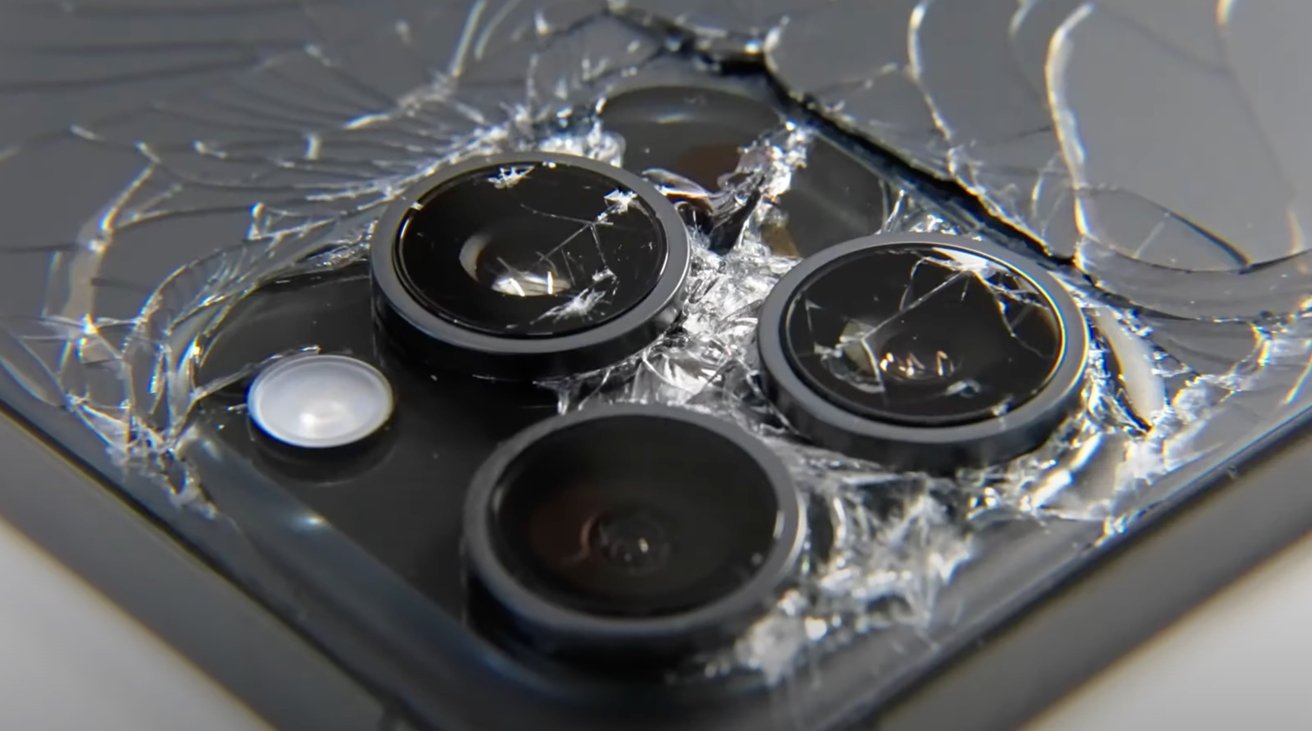Scientific drop testing shows that iPhone 15 Pro Max glass is no more fragile — or more durable — than other premium phones.
Consumer drop testing for shock value or entertainent after major smartphone releases is a common sight online. While trials by YouTubers may typically be discounted over a lack of scientific rigor, some outlets do actually apply scientific rigor to their approaches.
In the latest publicized test, Allstate Protection Plans put the $1,199 iPhone 15 Pro Max against the $1,199 Samsung Galaxy S23 Ultra, $1,799 Samsung Galaxy Z Fold5, and the $1,799 Google Pixel Fold. The insurer refers to it as the test of the "most expensive phones of the year."
All four devices survived a dunk test, which involved being kept under six feet of water for 30 minutes.
For the drop test, each was dropped from six feet onto a sidewalk. However, unlike being submerged, all of the devices experienced trouble.
The front screen-down drop test for the iPhone 15 Pro Max and the Galaxy S23 Ultra resulted in shattering on their first drops. Both were deemed unusable with raised and loose glass.
The Fold5 and Pixel Fold survived the main screen-down drop tests, handling two similar drops. Minor frame damage was encountered, along with corner scuffing and small screen dents.
For the back-down drop tests, the Pro Max and S23 Ultra again shattered on impact after a single drop. The Ultra was fully functional, but was only safe to do so when a case was used to cover the back panel.
The iPhone 15 Pro Max was also fully functional, barring the Main camera and Ultra Wide camera, which were shattered. Again, a case was needed to cover the rear.
The outer-screen-down drop tests for the Fold5 and Pixel Fold also resulted in shattering, with both displays unusable. The main screens were still fully functional, but were only safe to use when the outer screen panel wasn't in contact with the skin.
"Even though the most advanced smartphones today are made with space age materials like titanium, Armor Aluminum, and Ceramic Shield screens, they're still susceptible to damage when dropped on a concrete sidewalk," said Allstate Protection Plans VP of marketing and global creative officer Jason Siciliano. "That's especially troubling considering that our most recent survey shows that nearly half of Americans vastly underestimate the cost of smartphone repairs."
It is reckoned that 93 million Americans damaged a smartphone in the last 12 months, spending a total of $17.4 billion on repairs and replacements. Approximately 47% believe a smartphone repair costs $1450 or less, despite the average cost being $209, with premium models like the Pro Max costing far more.
 Malcolm Owen
Malcolm Owen







-m.jpg)






 Christine McKee
Christine McKee

 Marko Zivkovic
Marko Zivkovic

 Andrew Orr
Andrew Orr
 Andrew O'Hara
Andrew O'Hara
 William Gallagher
William Gallagher



-m.jpg)



14 Comments
While I appreciate the scientific rigor behind the tests, the six foot drop test isn't very informative because it's not a typical drop height. That's not to say that no one drops their phone from a six foot height or higher, but I didn't really need an "official test" to tell me that if I drop my iPhone horizontally from a height of six feet it was probably toast. Much more typically, drops are from a desk or table onto a hard floor... or drops from hand-height onto a floor or sidewalk... or drops from a pocket while standing, sitting or getting out of a car. What all these common drops have in common is that they range from 2.5 to maybe a 4 foot height. It would be great to test how these phones hold up in heights that are more typical.
When I worked at Agilent in the early 2000s they told me a story how they threw one of their optical wavemeters down three flights of stairs to test its durability.
I agree with people who correctly stated that a 6-foot drop test is largely meaningless, as the average drop height onto a hard surface is much less than that.
Even more frustrating is the fact that most people turn to YouTube video reviews to get a feel for what kind of protective case they should get, and yet few reviewers do drop testing. This is especially important for aesthetically pleasing cases like leather, which is known to rip when dropped, then leaving you with a case that looks worse than a silicone or plastic case that endured the same drop.
In other words, we need PROPER DROP TESTING not only for the naked Phones, but also for popular cases too. You'd think with the popularity of the iPhone spanning 15 years that we'd have more videos that show us proper testing! But no. We have almost no such testing at all. It's crazy.
Every iPhone generation, we are told the glass is stronger than the one before it
But every generation breaks just the same when you drop it
so what's the benefit of gorilla glass super duper +?